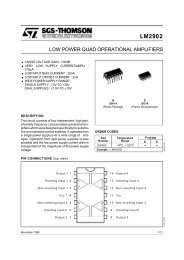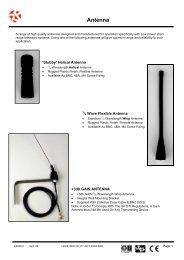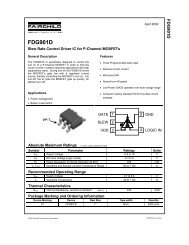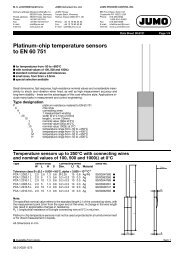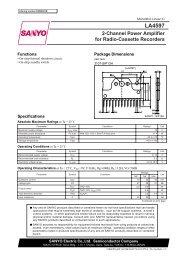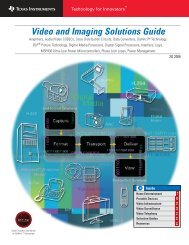Interface Selection Guide
Interface Selection Guide
Interface Selection Guide
Create successful ePaper yourself
Turn your PDF publications into a flip-book with our unique Google optimized e-Paper software.
S<br />
elect<br />
16<br />
➔<br />
UARTs (Universal Asynchronous Receiver/Transmitters)<br />
<strong>Selection</strong> <strong>Guide</strong><br />
Voltage Characterized<br />
Device Channel(s) FIFOs (V) Temp. (°C) Package(s) Description Price 1<br />
Universal Asynchronous Receiver/Transmitters (UARTs)<br />
TL16C2550 2 16-Byte 2,5/3.3/5 0 to 70, –40 to 85 32 QFN, 44 PLCC, Dual UART with Programmable Auto-RTS and Auto-CTS Call<br />
48 TQFP Available 2Q05<br />
TL16C2552 2 16-Byte 2.5/3.3/5 0 to 70, –40 to 85 32 QFN, 44 PLCC Dual UART with programmable Auto-RTS and Auto-CTS Call<br />
Available 2QO5<br />
TL16C450 1 None 5 0 to 70 40 DIP, 44 PLCC Single UART 1.50<br />
TL16C451 1 None 5 0 to 70 68 PLCC Single UART with Parallel Port 2.50<br />
TL16C452 2 None 5 0 to 70 68 PLCC Dual UART with Parallel Port 2.55<br />
TL16C550C 1 16-Byte 3.3/5 0 to 70, –40 to 85 40 DIP, 44 PLCC, Single UART with Hardware Autoflow Control 1.75<br />
48 LQFP, 48 TQFP<br />
TL16C550D 1 16-Byte 2.5/3.3/5 0 to 70, –40 to 85 32 QFN Single UART with Hardware Autoflow Control 1.75<br />
48 LQFP, 48 TQFP<br />
TL16C552 2 16-Byte 5 0 to 70, –40 to 85 68 PLCC Dual UART with Parallel Port; Recommend using TL16C552A 3.90<br />
TL16C552A 2 16-Byte 5 0 to 70, –40 to 85 68 PLCC, 80 TQFP Dual UART with Parallel Port 3.85<br />
TL16C554 4 16-Byte 5 0 to 70, –40 to 85 68 PLCC, 80 LQFP Quad UART; Recommend using TL16554A 6.05<br />
TL16C554A 4 16-Byte 5 0 to 70, –40 to 85 68 PLCC, 80 LQFP Quad UART with Hardware Autoflow Control 6.00<br />
TL16C750 1 16/64-Byte 5 0 to 70, –40 to 85 44 PLCC, 64 LQFP Single UART with Hardware Autoflow Control, Low-Power Modes 3.70<br />
TL16C752B 2 64-Byte 3.3 0 to 70, –40 to 85 48 LQFP, 48 TQFP Dual UART with Hardware Autoflow Control, Low-Power Modes 3.10<br />
TL16C752C 2 64-Byte 2.5/3.3/5 0 to 70, –40 to 85 32 QFN, 48 TLQFP Dual UART with Hardware Autoflow Control Call<br />
Lower Power Modes, RS485 and IrDA <strong>Interface</strong>, Available 3Q05<br />
TL16C754B 4 64-Byte 3.3/5 0 to 70, –40 to 85 68 PLCC, 80 LQFP Dual UART with Hardware Autoflow Control, Low-Power Modes 8.35<br />
TL16C754C 4 64-Byte 2.5/3.3/5 0 to 70, –40 to 85 80 LQFP Dual UART with Hardware Autoflow Control Call<br />
Lower Power Modes, Available 3Q05<br />
TL16PC564B/BLV 1 16/64-Byte 3.3/5 0 to 70 100 BGA, 100 LQFP Single UART with PCMCIA <strong>Interface</strong> 5.90/6.10<br />
TL16PIR552 2 16-Byte 5 0 to 70 80 QFP Dual UART with Selectable IR & 1284 Modes 6.10<br />
1<br />
Suggested resale price in U.S. dollars in quantities of 1,000.<br />
TL16C550D<br />
Get samples and datasheets at: www.ti.com/sc/device/TL16C550D<br />
Functional block diagram ( for PT and PFB packages)<br />
Asynchronous Communications Element<br />
with Autoflow Control<br />
The TL16C550D is a performance-enhanced<br />
version of TI’s industry-standard TL16C550C<br />
single-channel UART with 16-byte FIFO. The<br />
TL16C550D can support voltages of down to<br />
2.5 V and data transfer rates of up to 1.5<br />
Mbps. Combining these features with an<br />
ultra-small 32-pin QFN package, the<br />
TL16C550D is ideal for a variety of portable<br />
applications.<br />
Key Features<br />
• Expanded voltage and package options<br />
ideal for small form factors<br />
• Lower voltage and higher frequency than<br />
TL16C550C<br />
• Pin-for-pin replacement for TL16C550C<br />
• Programmable auto-RTS and auto-CTS<br />
(autoflow)<br />
• Up to 24/20/16-MHz clock rates for up<br />
to 1.5/1.25/1-Mbps operation<br />
• Programmable baud-rate generator<br />
allows division to generate internal 16x<br />
clock<br />
• Independent clock input receiver<br />
• Fully programmable serial interface<br />
characteristics<br />
• Available packages: DIP, PLCC, TQFP<br />
and QFN<br />
Applications<br />
• PDAs<br />
• MP3 players<br />
• Gaming systems<br />
• Modems<br />
• Serial ports<br />
• Telecom<br />
D(7–0)<br />
A0<br />
28<br />
27<br />
A1<br />
26<br />
A2<br />
9<br />
CS0<br />
10<br />
CS1<br />
11<br />
CS2<br />
24<br />
ADS<br />
35<br />
MR<br />
19<br />
RD1<br />
20<br />
RD2<br />
16<br />
WR1<br />
17<br />
WR2<br />
DDIS<br />
22<br />
23<br />
TXRDY<br />
14<br />
XIN<br />
15<br />
XOUT<br />
29<br />
RXRDY<br />
V 42 CC<br />
V<br />
18 SS<br />
4–2<br />
47–43<br />
Internal<br />
Data Bus<br />
Data<br />
Bus<br />
Buffer<br />
Select<br />
and<br />
Control<br />
Logic<br />
Power<br />
Supply<br />
8<br />
8<br />
Receiver<br />
Buffer<br />
Register<br />
Line<br />
Control<br />
Register<br />
Divisor<br />
Latch (LS)<br />
Divisor<br />
Latch (MS)<br />
Line<br />
Status<br />
Register<br />
Transmitter<br />
Holding<br />
Register<br />
Modem<br />
Control<br />
Register<br />
Modem<br />
Status<br />
Register<br />
Interrupt<br />
Enable<br />
Register<br />
Interrupt<br />
Identification<br />
Register<br />
FIFO<br />
Control<br />
Register<br />
8<br />
8<br />
Receiver<br />
FIFO<br />
Transmitter<br />
FIFO<br />
Baud<br />
Generator<br />
8<br />
8<br />
8<br />
Interrupt<br />
Control<br />
Logic<br />
S<br />
e<br />
l<br />
e<br />
c<br />
t<br />
8<br />
Receiver<br />
Shift<br />
Register<br />
Receiver<br />
Timing and<br />
Control<br />
Transmitter<br />
Timing and<br />
Control<br />
Transmitter<br />
Shift<br />
Register<br />
Modem<br />
Control<br />
Logic<br />
12<br />
7<br />
Autoflow<br />
Control<br />
(AFE)<br />
8<br />
SIN<br />
5<br />
RCLK<br />
32<br />
RTS<br />
38<br />
33<br />
39<br />
40<br />
41<br />
34<br />
31<br />
30<br />
BAUDOUT<br />
SOUT<br />
CTS<br />
DTR<br />
DSR<br />
DCD<br />
RI<br />
OUT1<br />
OUT2<br />
INTRPT<br />
<strong>Interface</strong> <strong>Selection</strong> <strong>Guide</strong> Texas Instruments 3Q 2005



